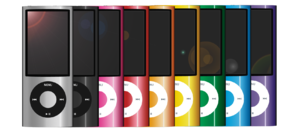 Image via Wikipedia
Image via WikipediaNike + iPod
As an intermediate runner, I have had experience with running shoes. I have also, through the course of my training, used different running watches and various pace trackers, many calorie and step counters. I have been looking for a product that is easy to use and provides better ways to track my running development. I have found this product; it is the Nike + iPod Sport Kit. It was revealed on March 21, 2006.
The Sport Kit can be used to measure and record the pace and distance of your run or walk. It has great features which make it easier to use, even for those who are not very good with technology. The kit consists of two components: the piezoelectric accelerometer and a Nike + shoe model. Piezoelectric means that the accelerometer generates an electric potential in response to applied mechanical stress, the foot. The accelerometer is nothing more than a small sensor that goes inside your shoe that keeps track of the number of steps, enabling you to focus on your training. Although I only mentioned two components to the kit, add an iPod to the list of components, sold separately.
To start using the kit, you first plug the receiver unit into the iPod, and then you navigate through the iPod menu. You then set a goal, whether you set it to a specific distance, a specific training time, or the number of calories burned. When the goal has been set, the receiver seeks the accelerometer, probably by asking the user to walk around to activate the sensor. This is a great feature because it is very helpful in tracking my progress. What makes it even better is that audio feedback is provided. You can even hear pre-recorded congratulations from an athletic star, like Lance Armstrong, Tiger Woods, or other very significant athletes. Depending on the type of workout chosen, different feedback will be provided. For goal-oriented workouts, feedback corresponds to significant milestones toward the goal. A distance workout will inform the user each time a mile or kilometer is completed, as well as the half-way point of the workout, and finally a countdown of four 100-meter increments as the workout comes to an end. This helps you track your training. It especially helps you stick to your training regime, especially by knowing how you're doing toward the completion of your workout.
Besides tracking your performance, Nike + integrates directly with the Nike website. Your workout data can be automatically uploaded during iPod sync with iTunes. The information uploaded isn't personally identifying. You have the ability to name runs online. There are also forums allowing you to interact online, meet and challenge others. You can also ask questions and give feedback. There is also a gallery where all user-created challenges are viewable.
It is much like a personal trainer. Feedback is provided while you're running— listen to your pace, time, distance and calories burned with your iPod. You can even see it all in the recently developed Nike + Sportband, released this month, April 2008. The sportband means you won't have to carry and iPod with you, which lowers the chance of muggings. Once you're done with your workout, take out the attached memory stick and plug it into your computer to sync your data with Nike.com.
Personally, the Nike + iPod Sport Kit makes running a lot more enjoyable. And participating in the online challenges is great.
This product would have been a great support to Ralph in helping him get better at running so he could have run a lot faster when he was running from the hunters in the last chapter of Lord of the Flies, "Cry of the Hunters." Ralph has to escape the other children, savages, who are trying to "smoke him out" of the forest on a deserted island. In the end they get rescued when Ralph runs into a naval officer who rescues them. They return to civility as they are being rescued. The naval officer is a representation of civility.
I think the only flaw some people might find is the cost. The Nike + iPod Sport Kit currently sells on the market for $29. The shoes range from $100 upwards. And an iPod nano 8GB is $200. The total comes out to about $350; this is assuming you have a computer.

